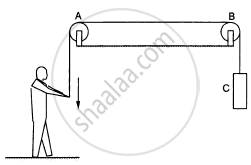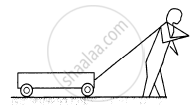Advertisements
Advertisements
प्रश्न
Two spherical bodies, each of mass 50 kg, are placed at a separation of 20 cm. Equal charges are placed on the bodies and it is found that the force of Coulomb repulsion equals the gravitational attraction in magnitude. Find the magnitude of the charge placed on either body.
उत्तर
Mass = 50 kg
Separation between the masses, r = 20 cm = 0.2 m
Let the change on each sphere be q.
Now, gravitational force, \[F_G = G\frac{\text{ m } _1 \text{ m } _2}{r^2}\]
\[= \frac{6.7 \times {10}^{- 11} \times \left( 50 \right)^2}{\left( 0 . 2 \right)^2}\]
\[ = \frac{6.7 \times {10}^{- 11} \times 2500}{0 . 04}\]
\[\text {Coulomb force}, \text {F_c} = \frac{1}{4\pi \in_0}\frac{q_1 q_2}{r^2}\]
\[ = 9 \times {10}^9 \frac{q^2}{0 . 04}\]
Since FG = Fc, we have :
\[\frac{6 . 7 \times {10}^{- 11} \times 2500}{0 . 04} = \frac{9 \times {10}^9 \times q^2}{0 . 04}\]
\[ \Rightarrow q^2 = \frac{6 . 7 \times {10}^{- 11} \times 2500}{9 \times {10}^9}\]
\[ = \frac{9 \times {10}^9}{0 . 04} = 1809 \times {10}^{- 18} \]
\[ \therefore q = \sqrt{18 . 09 \times {10}^{- 18}}\]
\[ = 4 . 3 \times {10}^{- 9} C\]
Thus, the charge of the spherical body is \[4 . 3 \times {10}^{- 9} C\]
APPEARS IN
संबंधित प्रश्न
List all the forces acting on (a) the pulley A, (b) the boy and (c) the block C in figure.

Figure shows a boy pulling a wagon on a road. List as many forces as you can which are relevant with this figure. Find the pairs of forces connected by Newton's third law of motion.

When Neils Bohr shook hand with Werner Heisenberg, what kind of force they exerted ?
Let E, G and N represent the magnitudes of electromagnetic gravitational and nuclear forces between two electrons at a given separation. Then
A 60 kg man pushes a 40 kg man by a force of 60 N. The 40 kg man has pushed the other man with a force of
The gravitational force acting on a particle of 1 g due to a similar particle is equal to 6.67 × 10−17 N. Calculate the separation between the particles.
The force with which the earth attracts an object is called the weight of the object. Calculate the weight of the moon from the following data : The universal constant of gravitation G = 6.67 × 11−11 N−m2/kg2, mass of the moon = 7.36 × 1022 kg, mass of the earth = 6 × 1024 kg and the distance between the earth and the moon = 3.8 × 105 km.
Find the ratio of the magnitude of the electric force to the gravitational force acting between two protons.
In tug of war, the team that exerts a larger tangential force on the ground wins. Consider the period in which a team is dragging the opposite team by applying a larger tangential force on the ground. List which of the following works are positive, which are negative and which are zero?
(a) work by the winning team on the losing team
(b) work by the losing team on the winning team
(c) work by the ground on the winning team
(d) work by the ground on the losing team
(e) total external work on the two teams.
The work done by the external forces on a system equals the change in
A particle is acted upon by a force of constant magnitude which is always perpendicular to the velocity of the plane. The motion of the particle takes place in a plane. It follows that
(a) its velocity is constant
(b) its acceleration is constant
(c) its kinetic energy is constant
(d) it moves in a circular path.
A block of mass 5.0 kg slides down an incline of inclination 30° and length 10 m. Find the work done by the force of gravity.
A particle moves from a point \[\overrightarrow{r}_1 = \left( 2 m \right) \overrightarrow{ i } + \left( 3 m \right) \overrightarrow{ j } \] to another point
\[\overrightarrow{r}_2 = \left( 3 m \right) \overrightarrow{ i } + \left( 2 m \right) \overrightarrow{ j } \] acts on it. Find the work done by the force on the particle during the displacement.
A block of mass m is kept over another block of mass M and the system rests on a horizontal surface (In the following figure). A constant horizontal force F acting on the lower block produces an acceleration \[\frac{F}{2 \left( m + M \right)}\] in the system, and the two blocks always move together. (a) Find the coefficient of kinetic friction between the bigger block and the horizontal surface. (b) Find the frictional force acting on the smaller block. (c) Find the work done by the force of friction on the smaller block by the bigger block during a displacement d of the system.

A box weighing 2000 N is to be slowly slid through 20 m on a straight track with friction coefficient 0⋅2 with the box. (a) Find the work done by the person pulling the box with a chain at an angle θ with the horizontal. (b) Find the work when the person has chosen a value of θ, which ensures him the minimum magnitude of the force.
A block of mass 2 kg kept at rest on an inclined plane of inclination 37° is pulled up the plane by applying a constant force of 20 N parallel to the incline. The force acts for one second. Find the kinetic energy of the block at the instant the force ceases to act. Take g = 10 m/s2.
A bicyclist comes to a skidding stop in 10 m. During this process, the force on the bicycle due to the road is 200 N and is directly opposed to the motion. The work done by the cycle on the road is ______.
A body is being raised to a height h from the surface of earth. What is the sign of work done by applied force?
